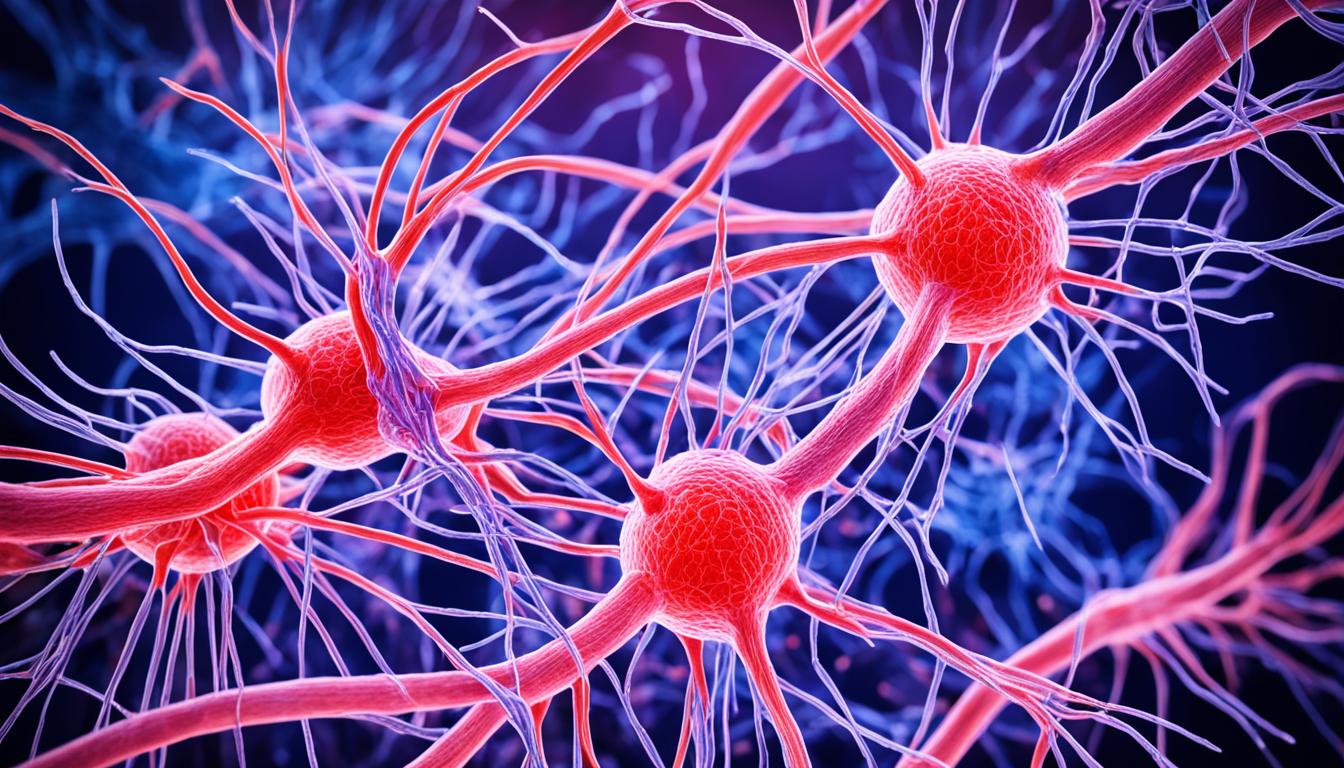Myasthenia gravis affects people of all ages. It brings muscle weakness and tiredness, whether you’re young or old. You might notice droopy eyelids, see double, find it hard to talk or swallow, feel weak.
This happens because the immune system acts against the muscle’s acetylcholine receptors. Genetic factors and issues with the thymus gland might also influence its development.
Detecting myasthenia gravis needs careful tests, like blood work and nerve checks. These look for antibodies that harm the acetylcholine receptors. This harm affects the way muscles and nerves communicate.
There are ways to handle myasthenia gravis. Doctors use drugs that boost acetylcholine, lower the effect of the immune system, and help remove harmful antibodies. Stem cell therapy is also promising as a future treatment.
Key Takeaways:
- Myasthenia gravis is a neuromuscular disorder characterized by muscle weakness and fatigue.
- Symptoms of myasthenia gravis include drooping eyelids, double vision, difficulty speaking and swallowing, and weakness of the limbs.
- An abnormal immune reaction targets the acetylcholine receptors in the muscles, leading to myasthenia gravis.
- Genetic predisposition and thymus gland abnormalities may contribute to the development of the condition.
- Diagnosis is made through a thorough clinical evaluation and specialized tests to detect the presence of antibodies.
- Treatment options include medications, immunosuppressive drugs, and therapies to remove antibodies from the blood.
- Stem cell therapy is an emerging treatment option for myasthenia gravis.
Understanding the Pathophysiology and Risk Factors of Myasthenia Gravis
Myasthenia gravis is a complex autoimmune disease. It affects the connection between nerves and muscles. This leads to muscle weakness and fatigue.
A key part of myasthenia gravis is an immune attack. This attack targets the acetylcholine receptors (AChRs) on muscle cells. As a result, nerve signals can’t properly reach the muscles.
Individuals with myasthenia gravis have AChR antibodies. These antibodies block or destroy AChRs. This stops the proper nerve-muscle communication, causing muscle weakness.
The exact cause of myasthenia gravis is still unknown. However, we do know of a few risk factors. For instance, issues with the thymus gland are common in people with this disease.
Genes are also important. Certain genetic traits make some more likely to get myasthenia gravis. But genetic factors aren’t the only things at play.
Things like viral infections or some medications can also influence the disease. These outside factors mix with our genetic makeup to trigger the condition.
Learning about the disease’s roots and risks helps in treatment. Specialists can use this knowledge to develop better therapies. These treatments aim to ease symptoms and slow down the disease.
Risk Factors for Myasthenia Gravis
| Risk Factors | Description |
|---|---|
| Thymus gland abnormalities | Individuals with myasthenia gravis often exhibit abnormalities in the thymus gland, suggesting a potential link between thymus dysfunction and disease development. |
| Genetic predisposition | Certain genetic variants have been associated with an increased susceptibility to myasthenia gravis, highlighting the role of genetics in disease development. |
| Acetylcholine receptor antibodies | Presence of AChR antibodies disrupts the normal functioning of acetylcholine receptors, resulting in muscle weakness and fatigue. |
| Anti-MuSK antibodies | Anti-MuSK antibodies interfere with the signaling pathway required for the proper functioning of muscle cells. They contribute to muscle weakness in myasthenia gravis. |
| Environmental factors | Viral infections and certain medications can trigger or worsen myasthenia gravis symptoms. This happens in people with a genetic predisposition to the disease. |
Diagnosing Myasthenia Gravis and Treatment Options
To diagnose myasthenia gravis, doctors do a full examination. They look at your history and do a check-up. They also use special tests, like antibody tests and nerve studies, to confirm the diagnosis.
Imaging tests check your thymus gland. This gland can cause problems if it’s abnormal. Finding these issues early is crucial for deciding on the best treatment.
The main aim of treating myasthenia gravis is to ease symptoms and lessen side effects. Doctors often give cholinesterase inhibitors to help with muscle strength. They might also use medicines that lower the autoimmune response.
For more serious cases, treatments like IVIG or plasmapheresis are options. These help by reducing the autoimmune effect and the symptoms it causes.
Sometimes, thymectomy is suggested. This is a surgery to remove the thymus gland. It can really help improve symptoms and lessen the need for long-term medicines.
It’s important to keep checking how well the treatment works. Working with your doctor and following a proper plan are crucial for a better life with myasthenia gravis.

